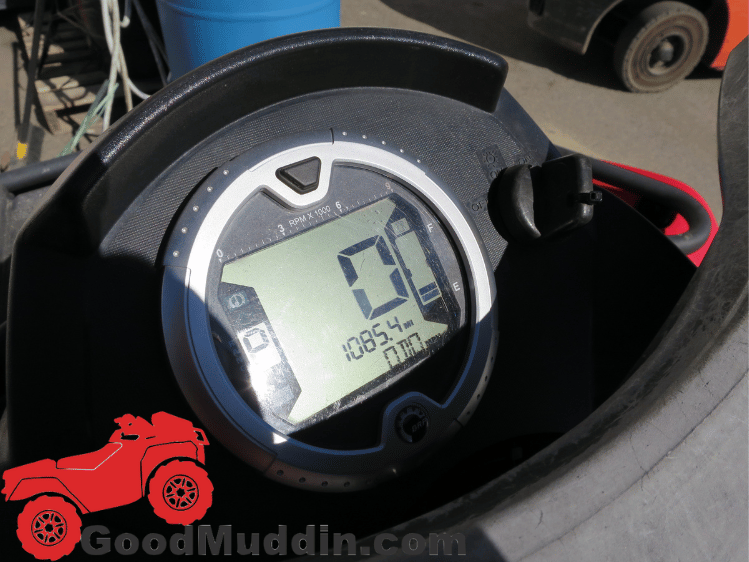If you’re in limp home mode, then it will be very obvious because the display will scroll those words or the “check engine” light will be one.
Another clue you’re in limp home mode is that the machine won’t go over 15 MPH, but this often has the check engine light going with it.
For side by sides, don’t confuse the seat-belt speed limited mode you enter when you don’t have your seat belt on. Can-AM side by sides require the driver to have their seat belt plugged in if they want to go over 12 MPH.
There are several potential causes that can trigger limp home mode in a Can-Am ATV. Most often, it’s abnormal readings from some sensor that cause it.
Here are some common factors that may lead to limp mode:
- Sensor Malfunction – If a critical sensor in the engine or transmission system detects a fault or abnormal readings, it can trigger it as a precautionary measure. I’ve seen rodents eat wires and cause a trigger.
- Bad battery – I’ve seen a battery that is dying start to throw a check engine light with a limp mode on the screen before. ATVs and side by side these days are using more power, and with so many riders adding many electrical accessories, you start to see more warning lights. The machine is looking for a range of voltage that it needs and when it goes under or beyond, it can throw it in that mode.
- Low engine oil – To protect the engine, if it detects low oil pressure, it will put in you in limp mode or even shut the engine off.
- Bad spark plugs – A misfire due to a bad spark plug is common and a reason for the ATV to go in this mode.
- Over working it when cold – ATV engines tend to be high-performance engines, and if you hop right on it and drive the snot out of out it, you can go into it. Let the ATV warm up for a minute, especially on cold days.
- Bad grounds – Just like having a bad battery, having bad grounds can throw a check engine or limp mode for your ATV. Make sure the grounds to the battery are nice and clean and on the frame too.
- Blown fuse – Sometimes a blown fuse can be the reason or throws a check engine light. Don’t forget to check the pins the fuse plugs into, I’ve seen many pins fall out and need to be pushed back in.
- Overheating – If the engine or transmission becomes excessively hot, the ATV may enter this mode to prevent further overheating and potential damage. Make sure to clean out your radiator (even if it looks clean), as a dirty one can lead to overheating and throw a check engine light with a limp mode. Use a good ATV cleaner like this here (ad).
- Bad gas or fuel system problems – ATV engines tend to be high-performance engines, so they can be picky about gas, especially fuel injected models. Make sure you’re running fresh gas.
- Transmission Problems – I do get guys who belts are slipping, and the speed gauge is reading all over the place and the ATV goes into this mode.
- Throttle Sensor Issues – Faulty throttle sensors can cause irregular readings and prompt the computer system to activate limp mode.
How To Remove It
To remove limp mode from your Can-Am, all you need to do is shut the engine off and let it sit for a few minutes.
Depending on the problem, it can be 2 minutes to 30 minutes. The limp mode goes away when the problem the machines is seeing goes away.
If limp mode does not go away after sitting, turn everything off and disconnect the negative battery cable for a few minutes, then reconnect it.
The fault codes that come up won’t go away, they may not display on the screen, but the computer has them stored for the dealership to fix when you bring it in.
If letting the ATV sit for a few minutes and disconnecting the battery for a few minutes does not remove the limp-mode, then you’ll need to bring the ATV in to your local dealership to be fixed. If the Can-AM is reporting the trouble codes or letting you know of the problem, you can try to fix it yourself, but only the B.U.D.S software that dealerships have will let you know the exact problem.
Don’t Drive When In Limp Mode
Ideally, you should not drive your ATV too long while in limp home mode.
Limp home mode is to get you somewhere safe, so you can get your ATV fixed. It’s basically, so you don’t get stranded when something goes wrong with your ATV or side by side.
If limp home mode doesn’t go away or keeps coming back, you need to look into it and take it to the dealership to get it fixed. Limp home mode is only activated when something is VERY out of scope, and it’s not a common thing.
Can-AM Limp Home Mode
Encountering limp home mode on your Can-Am ATV can be a confusing thing, but understanding its causes and potential solutions can help you fix the problem.
Limp home mode is a protective feature designed to prevent further damage to your ATV’s engine and other parts by limiting its performance when something is “out of normal operations”. Common triggers include sensor malfunctions, overheating, electrical problems, fuel issues, and transmission problems, among others.
While some causes can be addressed by simple remedies like checking the battery, spark plugs, letting the ATV sit or fuses, it’s important to consult a dealership or qualified technician if the problem persists.
